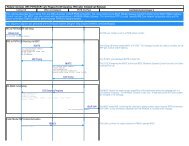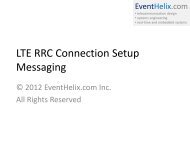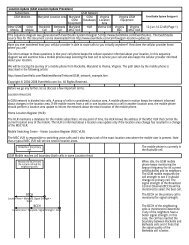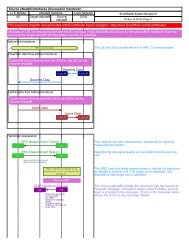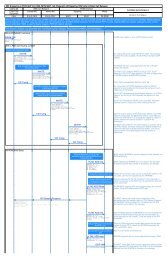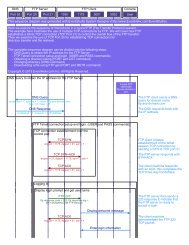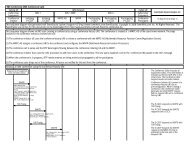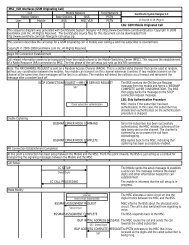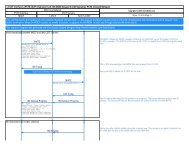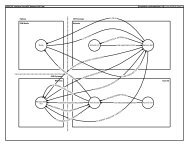LTE Radio Link Control (RLC) - EventHelix.com
LTE Radio Link Control (RLC) - EventHelix.com
LTE Radio Link Control (RLC) - EventHelix.com
Create successful ePaper yourself
Turn your PDF publications into a flip-book with our unique Google optimized e-Paper software.
<strong>EventHelix</strong>.<strong>com</strong>• tele<strong>com</strong>munication design• systems engineering• real-time and embedded systems3GPP <strong>LTE</strong> <strong>Radio</strong> <strong>Link</strong> <strong>Control</strong>(<strong>RLC</strong>) Sub Layer© 2009 <strong>EventHelix</strong>.<strong>com</strong> Inc.All Rights Reserved.
Uplink <strong>RLC</strong> Sub LayerInterfaces<strong>EventHelix</strong>.<strong>com</strong>• tele<strong>com</strong>munication design• systems engineering• real-time and embedded systems<strong>Radio</strong> BearersPDCPROHCSecurityROHCSecurity<strong>RLC</strong>Segm.ARQ etc...Segm.ARQ etcCCCHLogical ChannelsScheduling / Priority HandlingMACMultiplexingHARQTransport Channels© 2009 <strong>EventHelix</strong>.<strong>com</strong> Inc. 5
Looking Toward College: A Residential Program for High School Women………. 44Math Week at Meredith…………………………………………………………….. 45Performing Arts Camp…………………………………………………………........ 45Piano Camp…………………………………………………………………………. 46Science Camp……………………………………………………………………….. 46Summer Arts Academy……………………………………………………………... 47Youth Writers’ Camp……………………………………………………………….. 47NORTH CAROLINA A&T UNIVERSITYAll-Star Math Camp……………………………………………………………........ 48Energy Engineers Starter Program (EESP)…………………………………………. 48Engineer Starters Program………………………………………………………….. 49Higher Learning Institute………………………………………………………........ 49Institute for Future Agricultural Leaders………………………………………........ 50Math and Science Education Network (MSEN) Pre-College Program…………….. 50Para-Research Program (PRP)…………………………………………………........ 51Partnership in Education and Research (PIER)…………………………………….. 51Professional Accounting Career Exploration Program (PACE)……………………. 52Research Apprenticeship Program (RAP)………………………………………….. 52Summer High School Transportation Institute……………………………………... 53Upward Bound…………………………………………………………………........ 53NORTH CAROLINA CENTRAL UNIVERSITYAcademic Summer Accelerated Program…………………………………………... 54Algebra Camp………………………………………………………………………. 54Computer Graphics…………………………………………………………………. 55Computer Science Camp……………………………………………………………. 55Elementary Summer Academic Program-Boys…………………………………….. 56Elementary Summer Academic Program-Girls…………………………………….. 56Lights, Camera, Action……………………………………………………………... 57Measurement and Geometry………………………………………………………... 57North Carolina Adventure…………………………………………………………... 58NASA/EXORT/SPUR…………………………………………………………........ 58Pre-Algebra Enrichment…………………………………………………………….. 59Project R.E.A.C.H…………………………………………………………………... 59String Camp……………………………………………………………………........ 60Summer Bridges Writing Institute………………………………………………….. 60Summer Ventures in Science and Mathematics…………………………………...... 61SAT Preparation…………………………………………………………………….. 61Twenty-first Century Community Summer Academy…………………………........ 62NORTH CAROLINA COMMISSION OF INDIAN AFFAIRSTalent Search………………………………………………………………………... 62NORTH CAROLINA SCHOOL OF THE ARTSNCSA Summer Session…………………………………………………………….. 63ivwww.cfnc.org
Unacknowledged ModeTransmit Overview<strong>EventHelix</strong>.<strong>com</strong>• tele<strong>com</strong>munication design• systems engineering• real-time and embedded systems1. Receive from PDCP / RRC2. Add to Transmission Buffer3. Segmentation and Concatenation4. Add <strong>RLC</strong> Header5. Pass to MAC Sub Layer1. Receive the upper layerSDU from PDCP or RRC.2. Add the SDU to thetransmit buffer.3. Segment the SDU into <strong>RLC</strong>PDUs when the MACscheduler permitstransmission.4. Add the <strong>RLC</strong> header to the<strong>RLC</strong> PDU.5. Pass the <strong>RLC</strong> PDUs to MACfor transmission over theair.© 2009 <strong>EventHelix</strong>.<strong>com</strong> Inc. 9
Unacknowledged ModeReceive Overview<strong>EventHelix</strong>.<strong>com</strong>• tele<strong>com</strong>munication design• systems engineering• real-time and embedded systems1. Receive from MAC Sub Layer2. Remove <strong>RLC</strong> Header3. Reassemble PDUs4. Pass to PDCP / RRC1. The MAC layer passesthe received <strong>RLC</strong> PDUsto the <strong>RLC</strong> layer.2. The <strong>RLC</strong> layer removesthe <strong>RLC</strong> header.3. The <strong>RLC</strong> layer assemblesan upper layer SDUs ifreceipt of an <strong>RLC</strong> PDU<strong>com</strong>pletes the assemblyof the SDU.4. Pass the assembledSDUs to the PDCP orRRC layers.© 2009 <strong>EventHelix</strong>.<strong>com</strong> Inc. 10
Unacknowledged ModeState Variables<strong>EventHelix</strong>.<strong>com</strong>• tele<strong>com</strong>munication design• systems engineering• real-time and embedded systemsVT(US) Send State Variable• Holds the value of the SN to be assigned for the next newly generated UMD PDU.• It is initially set to 0, and is updated whenever the UM <strong>RLC</strong> entity delivers an UMD PDU with SN =VT(US).VR(UR) UM receive state variable• Holds the value of the SN of the earliest UMD PDU that is still considered for reordering.• It is initially set to 0.VR(UX) UM t-Reordering state variable• This state variable holds the value of the SN following the SN of the UMD PDU which triggered t-Reordering.VR(UH) UM highest received state variable• This state variable holds the value of the SN following the SN of the UMD PDU with the highest SNamong received UMD PDUs• Serves as the higher edge of the reordering window. It is initially set to 0.© 2009 <strong>EventHelix</strong>.<strong>com</strong> Inc. 11
<strong>EventHelix</strong>.<strong>com</strong>• tele<strong>com</strong>munication design• systems engineering• real-time and embedded systems3GPP <strong>LTE</strong> <strong>Radio</strong> <strong>Link</strong> <strong>Control</strong> (<strong>RLC</strong>) Sub LayerACKNOWLEDGED MODE© 2009 <strong>EventHelix</strong>.<strong>com</strong> Inc. 12
Acknowledged ModeTransmit Overview<strong>EventHelix</strong>.<strong>com</strong>• tele<strong>com</strong>munication design• systems engineering• real-time and embedded systems1. Receive from PDCP / RRC 1. Receive the upper layer SDUfrom PDCP or RRC.2. Add the SDU to the transmitbuffer.3. Segment the SDU into <strong>RLC</strong>PDUs when the MACscheduler permitstransmission.4. Make a copy of the transmitbuffer for possibleretransmissions.5. Add <strong>RLC</strong> Header5. Add the <strong>RLC</strong> header to the<strong>RLC</strong> PDUs.6.6. Pass to MAC Sub LayerPass the <strong>RLC</strong> PDUs to MACfor transmission over the air.2. Add to Transmission Buffer3. Segmentation and Concatenation4. Keep a Copy for Retransmission© 2009 <strong>EventHelix</strong>.<strong>com</strong> Inc. 13
Acknowledged ModeReceive Overview<strong>EventHelix</strong>.<strong>com</strong>• tele<strong>com</strong>munication design• systems engineering• real-time and embedded systems1. Receive from MAC Sub Layer2. Remove <strong>RLC</strong> Header3. Mark for Positive Acknowledgement4. Reassemble PDUs5. Pass to PDCP / RRC1. The MAC layer passes thereceived <strong>RLC</strong> PDU to the <strong>RLC</strong>layer.2. The <strong>RLC</strong> layer removes the <strong>RLC</strong>header.3. The <strong>RLC</strong> PDU is receivedcorrectly, so mark the block forpositive acknowledgement.– Acknowledgements are sentperiodically to the remote peer.4. The <strong>RLC</strong> layer assembles anupper layer SDUs if receipt ofan <strong>RLC</strong> PDU <strong>com</strong>pletes theassembly of the SDU.5. Pass the assembled SDUs to thePDCP or RRC layers.© 2009 <strong>EventHelix</strong>.<strong>com</strong> Inc. 14
Acknowledged Mode: ReceivedPositive Acknowledgement - Overview<strong>EventHelix</strong>.<strong>com</strong>• tele<strong>com</strong>munication design• systems engineering• real-time and embedded systems1. Received Positive Acknowledgement2. Remove from Retransmission QueueFree buffer released from retransmissionqueue3. Update the receive sequence numberto allow further transmissions1. A positiveacknowledgement isreceived from theremote end.2. Access theretransmission queueand remove the bufferas it has beenacknowledged.3. Update the receivedsequence numbers toadvance the slidingwindow.© 2009 <strong>EventHelix</strong>.<strong>com</strong> Inc. 15
Acknowledged Mode: ReceivedNegative Acknowledgement -Overview1. Received a NegativeAcknowledgement2. Extract the <strong>RLC</strong> PDU that needsto be retransmitted3. Retransmit the BufferRe-segment if the MAC cannot transmitbursts with original length<strong>EventHelix</strong>.<strong>com</strong>• tele<strong>com</strong>munication design• systems engineering• real-time and embedded systems1. A negativeacknowledgement isreceived from theremote end.2. Access theretransmission queueand extract the bufferfor retransmission.3. Retransmit the buffer– If MAC does not supportthe original transmissionrate, re-segment the <strong>RLC</strong>block into the smalleravailable block size© 2009 <strong>EventHelix</strong>.<strong>com</strong> Inc. 16
Acknowledged Mode: ReceivedRetransmission - Overview<strong>EventHelix</strong>.<strong>com</strong>• tele<strong>com</strong>munication design• systems engineering• real-time and embedded systems1. Received a retransmission for apreviously negatively acknowledged<strong>RLC</strong> PDU2. Update the receive buffer andcheck if the retransmission fills holesin previously received data3. Reassemble all the received insequence data and pass thereassembled SDUs to RRC/PDCP1. A retransmission for apreviously negativelyacknowledged <strong>RLC</strong> PDU isreceived.2. Update the received databuffer– The received buffer may filla hole in the previouslyreceived data.3. Assemble all the insequence received datainto SDUs– Pass the received SDUs tothe RRC or PDCP layers.© 2009 <strong>EventHelix</strong>.<strong>com</strong> Inc. 17
Acknowledged Mode StateVariables<strong>EventHelix</strong>.<strong>com</strong>• tele<strong>com</strong>munication design• systems engineering• real-time and embedded systemsTransmitReceiveVT(A): Acknowledged State VariableVT(MS): Maximum Send State VariableVT(S): Send State VariablePOLL_SN: Poll Send State VariablePDU_WITHOUT_POLL CounterBYTE_WITHOUT_POLL CounterRETX_COUNT CounterVR(R): Receive State VariableVR(MR): Maximum Accepted ReceiveState VariableVR(X): Reordering State VariableVR(MS): Maximum STATUS TransmitState VariableVR(H): Highest Received State Variable© 2009 <strong>EventHelix</strong>.<strong>com</strong> Inc. 18
Acknowledged ModeTransmit State Variables<strong>EventHelix</strong>.<strong>com</strong>• tele<strong>com</strong>munication design• systems engineering• real-time and embedded systemsVT(A) Acknowledgement state variable• Holds the value of the SN of the next AMD PDU for which a positive acknowledgment is to be receivedin-sequence• Serves as the lower edge of the transmitting window.• It is initially set to 0, and is updated whenever a positive acknowledgment for an AMD PDU with SN =VT(A) is receivedVT(MS) Maximum send state variable• This state variable equals VT(A) + AM_Window_Size• It serves as the higher edge of the transmitting window.VT(S) Send state variable• This state variable holds the value of the SN to be assigned for the next newly generated AMD PDU.• It is initially set to 0, and is updated whenever the AM <strong>RLC</strong> entity delivers an AMD PDU with SN =VT(S).POLL_SN Poll send state variable• This state variable holds the value of VT(S)-1 upon the most recent transmission of a <strong>RLC</strong> data PDUwith the poll bit set to “1”. It is initially set to 0.© 2009 <strong>EventHelix</strong>.<strong>com</strong> Inc. 19
Acknowledged ModeTransmit Procedure<strong>EventHelix</strong>.<strong>com</strong>• tele<strong>com</strong>munication design• systems engineering• real-time and embedded systemsThe Transmit AM <strong>RLC</strong> entity maintains a transmitting window such thatTransmit Serial Number (SN) falls within the Transmit window [VT(A)
Acknowledged ModeReceive State Variables<strong>EventHelix</strong>.<strong>com</strong>• tele<strong>com</strong>munication design• systems engineering• real-time and embedded systemsVR(R) Receive state variable•Holds the value of the SN following the last in-sequence <strong>com</strong>pletely received AMD PDU•It serves as the lower edge of the receiving window.•It is initially set to 0, and is updated whenever an AMD PDU with SN = VR(R) is received.VR(MR) Maximum acceptable receive state variable•This state variable equals VR(R) + AM_Window_Size, and it holds the value of the SN of the first AMD PDU that is beyondthe receiving window•Serves as the higher edge of the receiving window.VR(X) t-Reordering state variable•This state variable holds the value of the SN following the SN of the <strong>RLC</strong> data PDU which triggered t-Reordering.VR(MS) Maximum STATUS transmit state variable•This state variable holds the highest possible value of the SN which can be indicated by “ACK_SN” when a STATUS PDUneeds to be constructed. It is initially set to 0.VR(H) Highest received state variable•This state variable holds the value of the SN following the SN of the <strong>RLC</strong> data PDU with the highest SN among received<strong>RLC</strong> data PDUs. It is initially set to 0.© 2009 <strong>EventHelix</strong>.<strong>com</strong> Inc. 21
<strong>RLC</strong> ConfigurableParameters<strong>EventHelix</strong>.<strong>com</strong>• tele<strong>com</strong>munication design• systems engineering• real-time and embedded systemsmaxRetxThreshold• This parameter is used by the transmitting side of eachAM <strong>RLC</strong> entity to limit the number of retransmissions ofan AMD PDU.pollPDU• This parameter is used by the transmitting side of eachAM <strong>RLC</strong> entity to trigger a poll for every pollPDU PDUs.pollByte• This parameter is used by the transmitting side of eachAM <strong>RLC</strong> entity to trigger a poll for every pollByte bytes.sn-FieldLength• This parameter gives the UM SN field size in bits.© 2009 <strong>EventHelix</strong>.<strong>com</strong> Inc. 22
<strong>RLC</strong> Priority<strong>EventHelix</strong>.<strong>com</strong>• tele<strong>com</strong>munication design• systems engineering• real-time and embedded systems• The transmitting side of an AM <strong>RLC</strong> entity shallprioritize transmission of <strong>RLC</strong> control PDUsover <strong>RLC</strong> data PDUs.• The transmitting side of an AM <strong>RLC</strong> entityshall prioritize retransmission of <strong>RLC</strong> dataPDUs over transmission of new AMD PDUs.© 2009 <strong>EventHelix</strong>.<strong>com</strong> Inc. 23
<strong>EventHelix</strong>.<strong>com</strong>• tele<strong>com</strong>munication design• systems engineering• real-time and embedded systems3GPP <strong>LTE</strong> <strong>Radio</strong> <strong>Link</strong> <strong>Control</strong> (<strong>RLC</strong>) Sub Layer<strong>RLC</strong> PDU FORMATS© 2009 <strong>EventHelix</strong>.<strong>com</strong> Inc. 24
TMD PDU<strong>EventHelix</strong>.<strong>com</strong>• tele<strong>com</strong>munication design• systems engineering• real-time and embedded systemsData...Oct 1Oct N• Transparent Mode PDUs just contain Data• No headers are included© 2009 <strong>EventHelix</strong>.<strong>com</strong> Inc. 25
UMD PDU-1<strong>EventHelix</strong>.<strong>com</strong>• tele<strong>com</strong>munication design• systems engineering• real-time and embedded systemsFIEData...SNOct 1Oct 2Oct NR1 R1 R1 FI E SNSNData...Oct 1Oct 2Oct 3Oct NUMD PDU with 5 bit Serial NumberUMD PDU with 10 bit Serial Number• An UM <strong>RLC</strong> entity is configured by RRC to use either a 5 bit SN or a10 bit SN.• An UMD PDU header needs to be extended when more thanmultiple Data field elements need to be sent.– In that which case an E and a LI are present for every Data fieldelement except the last.– Furthermore, when an UMD PDU header consists of an odd number ofLI(s), four padding bits follow after the last LI.– See next two slides© 2009 <strong>EventHelix</strong>.<strong>com</strong> Inc. 26
UMD PDU -2<strong>EventHelix</strong>.<strong>com</strong>• tele<strong>com</strong>munication design• systems engineering• real-time and embedded systemsUMD PDU (5 bit SN) with OddNumber of LIsUMD PDU (5 bit SN) with EvenNumber of LIsP re se n tifK > = 3F I EE L I 1L I 1S NE L I 2 (ifK > = 3 )L I 2.O ct1O ct2O ct3O ct4E L I K-2O ct[2 .5 + 1 .5 *K -5 ]L I K-2 E L I K-1 O ct[2 .5 + 1 .5 *K -4 ]L I K-1 O ct[2 .5 + 1 .5 *K -3 ]EL I KO ct[2 .5 + 1 .5 *K -2 ]L I K P a d d in gO ct[2 .5 + 1 .5 *K -1 ]D a taO ct[2 .5 + 1 .5 *K ].O ctNF I EE L I 1L I 1S NE L I 2L I 2.O ct1O ct2O ct3O ct4E L I K-1O ct[2 + 1 .5 *K -3 ]L I K-1 E L I K O ct[2 + 1 .5 *K -2 ]L I K O ct[2 + 1 .5 *K -1 ]D a taO ct[2 + 1 .5 *K ].O ctN© 2009 <strong>EventHelix</strong>.<strong>com</strong> Inc. 27
UMD PDU -3<strong>EventHelix</strong>.<strong>com</strong>• tele<strong>com</strong>munication design• systems engineering• real-time and embedded systemsUMD PDU (10 bit SN) with OddNumber of LIsUMD PDU (10 bit SN) with EvenNumber of LIsP re se n tifK > = 3R 1 R 1 R 1 F I E S NS NE L I 1L I 1E L I 2 (ifK > = 3 )L I 2.O ct1O ct2O ct3O ct4O ct5E L I K-2O ct[2 .5 + 1 .5 *K -4 ]L I K-2 E L I K-1 O ct[2 .5 + 1 .5 *K -3 ]L I K-1 O ct[2 .5 + 1 .5 *K -2 ]EL I KO ct[2 .5 + 1 .5 *K -1 ]L I K P a d d in gO ct[2 .5 + 1 .5 *K ]D a taO ct[2 .5 + 1 .5 *K + 1 ].O ctNR 1 R 1 R 1 F I E S NS NE L I 1L I 1E L I 2L I 2.O ct1O ct2O ct3O ct4O ct5E L I K-1O ct[2 + 1 .5 *K -2 ]L I K-1 E L I K O ct[2 + 1 .5 *K -1 ]L I K O ct[2 + 1 .5 *K ]D a taO ct[2 + 1 .5 *K + 1 ].O ctN© 2009 <strong>EventHelix</strong>.<strong>com</strong> Inc. 28
UMD PDU Fields - 1<strong>EventHelix</strong>.<strong>com</strong>• tele<strong>com</strong>munication design• systems engineering• real-time and embedded systemsSequence Number (SN) – 5 or 10 bit• The SN field indicates the sequence number of the corresponding UMD PDU.• The sequence number is incremented by one for every UMD PDU.Extension bit (E) – 1 bit• The E field indicates whether Data field follows or a set of E field and LI fieldfollows.Framing Info (FI) – 2 bit• The FI field indicates whether a <strong>RLC</strong> SDU is segmented at the beginningand/or at the end of the Data field.• Specifically, the FI field indicates whether the first byte of the Data fieldcorresponds to the first byte of a <strong>RLC</strong> SDU, and whether the last byte of theData field corresponds to the last byte of a <strong>RLC</strong> SDU.© 2009 <strong>EventHelix</strong>.<strong>com</strong> Inc. 29
UMD PDU Fields - 2<strong>EventHelix</strong>.<strong>com</strong>• tele<strong>com</strong>munication design• systems engineering• real-time and embedded systemsReserved 1 (R1) – 1 bit• The R1 field is a reserved field for this release of the protocol.Length Indicator (LI) - 11 bit• The LI field indicates the length in bytes of the corresponding Datafield element present in the <strong>RLC</strong> data PDU delivered/received by anUM or an AM <strong>RLC</strong> entity.• The first LI present in the <strong>RLC</strong> data PDU header corresponds to thefirst Data field element present in the Data field of the <strong>RLC</strong> data PDU,• The second LI present in the <strong>RLC</strong> data PDU header corresponds tothe second Data field element present in the Data field of the <strong>RLC</strong>data PDU, and so on.• The value 0 is reserved.© 2009 <strong>EventHelix</strong>.<strong>com</strong> Inc. 30
AMD PDU - 1<strong>EventHelix</strong>.<strong>com</strong>• tele<strong>com</strong>munication design• systems engineering• real-time and embedded systemsD /C R F P F I E S NS ND ata.O ct1O ct2O ct3O ctN• AMD PDU consists of a Data field and an AMD PDU header.• AMD PDU header consists of a fixed part (fields that are present for every AMDPDU) and an extension part• An AMD PDU header needs to be extended when more than multiple Data fieldelements need to be sent.– In that which case an E and a LI are present for every Data field element except the last.– When an UMD PDU header consists of an odd number of LI(s), four padding bits follow afterthe last LI.– See next slide© 2009 <strong>EventHelix</strong>.<strong>com</strong> Inc. 31
AMD PDU - 2<strong>EventHelix</strong>.<strong>com</strong>• tele<strong>com</strong>munication design• systems engineering• real-time and embedded systemsOdd Number of LIsEvent Number of LIsP resentifK >= 3D /C R F P F I E S NS NE L I 1L I 1E L I 2 (ifK >=3)L I 2.O ct1O ct2O ct3O ct4O ct5E L I K-2O ct[2.5+1.5*K -4]L I K-2 E L I K-1 O ct[2.5+1.5*K -3]L I K-1 O ct[2.5+1.5*K -2]EL I KO ct[2.5+1.5*K -1]L I K P addingO ct[2.5+1.5*K ]D ataO ct[2.5+1.5*K +1].O ctND /C R F P F I E S NS NE L I 1L I 1E L I 2L I 2.O ct1O ct2O ct3O ct4O ct5E L I K-1O ct[2+1.5*K -2]L I K-1 E L I K O ct[2+1.5*K -1]L I K O ct[2+1.5*K ]D ataO ct[2+1.5*K +1].O ctN© 2009 <strong>EventHelix</strong>.<strong>com</strong> Inc. 32
AMD PDU Specific Fields<strong>EventHelix</strong>.<strong>com</strong>• tele<strong>com</strong>munication design• systems engineering• real-time and embedded systemsData/<strong>Control</strong> (D/C) – 1 bit• The D/C field indicates whether the <strong>RLC</strong> PDU is a <strong>RLC</strong> data PDU or <strong>RLC</strong> control PDU.Re-segmentation Flag (RF) – 1 bit• The RF field indicates whether the <strong>RLC</strong> PDU is an AMD PDU or AMD PDU segment.Polling bit (P) – 1 bit• The P field indicates whether or not the transmitting side of an AM <strong>RLC</strong> entity requests aSTATUS report from its peer AM <strong>RLC</strong> entity.Sequence Number (SN) - 10 bit• The SN field indicates the sequence number of the corresponding AMD PDU.• For an AMD PDU segment, the SN field indicates the sequence number of the original AMDPDU from which the AMD PDU segment was constructed from.• The sequence number is incremented by one for every AMD PDU.© 2009 <strong>EventHelix</strong>.<strong>com</strong> Inc. 33
AMD PDU Segment - 1<strong>EventHelix</strong>.<strong>com</strong>• tele<strong>com</strong>munication design• systems engineering• real-time and embedded systemsD /C R F P F I E S NS NL S FS OS OD ata.O ct1O ct2O ct3O ct4O ct5O ctN• AMD PDUs can be further segmented into AMD PDU Segments• AMD PDU segment header consists of a fixed part and an extension part.• An AMD PDU segment header needs to be extended when more thanmultiple Data field elements need to be sent.– In that which case an E and a LI are present for every Data field elementexcept the last.– When an UMD PDU header consists of an odd number of LI(s), four paddingbits follow after the last LI.– See next slide© 2009 <strong>EventHelix</strong>.<strong>com</strong> Inc. 34
AMD PDU Segment - 2<strong>EventHelix</strong>.<strong>com</strong>• tele<strong>com</strong>munication design• systems engineering• real-time and embedded systemsOdd Number of LIsEven Number of LIsP resentifK >= 3D /C R F P F I E S NS NL S FS OS OE L I 1L I 1E L I 2 (ifK >=3)L I 2.O ct1O ct2O ct3O ct4O ct5O ct6O ct7E L I K-2O ct[4.5+1.5*K -4]L I K-2 E L I K-1 O ct[4.5+1.5*K -3]L I K-1 O ct[4.5+1.5*K -2]EL I KO ct[4.5+1.5*K -1]L I K P addingO ct[4.5+1.5*K ]D ataO ct[4.5+1.5*K +1].O ctND /C R F P F I E S NS NL S FS OS OE L I 1L I 1E L I 2L I 2.O ct1O ct2O ct3O ct4O ct5O ct6O ct7E L I K-1O ct[4+1.5*K -2]L I K-1 E L I K O ct[4+1.5*K -1]L I K O ct[4+1.5*K ]D ataO ct[4+1.5*K +1].O ctN© 2009 <strong>EventHelix</strong>.<strong>com</strong> Inc. 35
AMD PDU SegmentSpecific Fields<strong>EventHelix</strong>.<strong>com</strong>• tele<strong>com</strong>munication design• systems engineering• real-time and embedded systemsSO start (SOstart) - 15 bit• The SOstart field indicates the portion of the AMD PDU with SN = NACK_SN thathas been detected as lost at the receiving side of the AM <strong>RLC</strong> entity.• The SOstart field indicates the position of the first byte of the portion of the AMDPDU in bytes within the Data field of the AMD PDU. The first byte in the Data fieldof the original AMD PDU is referred by the SOstart field value 0.SO end (SOend) – 15 bit• The SOend field indicates the portion of the AMD PDU with SN = NACK_SN thathas been detected as lost at the receiving side of the AM <strong>RLC</strong> entity.• The SOend field indicates the position of the last byte of the portion of the AMDPDU in bytes within the Data field of the AMD PDU.• The special SOend value "111111111111111" is used to indicate that the missingportion of the AMD PDU includes all bytes to the last byte of the AMD PDU.© 2009 <strong>EventHelix</strong>.<strong>com</strong> Inc. 36
D /CC P TA C K _S NSTATUS PDUA C K _S NE 1N A C K _S NE 1 E 2 N A C K _S NN A C K _S NE 1 E 2S O startS O startS O endS O endS O endN A C K _S N.O ct1O ct2O ct3O ct4O ct5O ct6O ct7O ct8O ct9<strong>EventHelix</strong>.<strong>com</strong>• tele<strong>com</strong>munication design• systems engineering• real-time and embedded systems• STATUS PDU is used to sendacknowledgements for received PDUs.• Consists of payload and a <strong>RLC</strong> controlPDU header.• The payload starts from the first bitfollowing the <strong>RLC</strong> control PDU header,and it consists of:– One ACK_SN and one E1– Zero or more sets of a NACK_SN, an E1and an E2– Possibly a set of a SOstart and a SOendfor each NACK_SN.– When necessary one to seven paddingbits are included in the end of theSTATUS PDU to achieve octet alignment.© 2009 <strong>EventHelix</strong>.<strong>com</strong> Inc. 37
Status PDU Fields<strong>EventHelix</strong>.<strong>com</strong>• tele<strong>com</strong>munication design• systems engineering• real-time and embedded systemsAcknowledgement SN (ACK_SN) – 10 bit• The ACK_SN field indicates the SN of the next not received <strong>RLC</strong> Data PDU which is not reportedas missing in the STATUS PDU.• When the transmitting side of an AM <strong>RLC</strong> entity receives a STATUS PDU, it interprets that allAMD PDUs up to but not including the AMD PDU with SN = ACK_SN have been received by itspeer AM <strong>RLC</strong> entity,• excluding those AMD PDUs indicated in the STATUS PDU with NACK_SN and portions of AMDPDUs indicated in the STATUS PDU with NACK_SN, SOstart and SOend.Negative Acknowledgement SN (NACK_SN) – 10 bit• The NACK_SN field indicates the SN of the AMD PDU (or portions of it) that has been detectedas lost at the receiving side of the AM <strong>RLC</strong> entity.<strong>Control</strong> PDU Type (CPT) – 3 bit• The CPT field indicates the type of the <strong>RLC</strong> control PDU.• A value of 0 represents the STATUS PDU. All other values are reserved.© 2009 <strong>EventHelix</strong>.<strong>com</strong> Inc. 38
Explore More<strong>EventHelix</strong>.<strong>com</strong>• tele<strong>com</strong>munication design• systems engineering• real-time and embedded systemsSpecification3GPP TS 36.3223GPP TS 36.3003GPP TS 36.3213GPP TS 36.211TitleEvolved Universal Terrestrial <strong>Radio</strong> Access (E-UTRA)<strong>Radio</strong> <strong>Link</strong> <strong>Control</strong> (<strong>RLC</strong>) protocol specificationEvolved Universal Terrestrial <strong>Radio</strong> Access (E-UTRA) andEvolved Universal Terrestrial <strong>Radio</strong> Access Network (E-UTRAN);Overall description; Stage 2Evolved Universal Terrestrial <strong>Radio</strong> Access (E-UTRA); MediumAccess <strong>Control</strong> (MAC) protocol specificationEvolved Universal Terrestrial <strong>Radio</strong> Access (E-UTRA); Physicalchannels and modulation© 2009 <strong>EventHelix</strong>.<strong>com</strong> Inc. 39
Thank You<strong>EventHelix</strong>.<strong>com</strong>• tele<strong>com</strong>munication design• systems engineering• real-time and embedded systemsThank you for visiting <strong>EventHelix</strong>.<strong>com</strong>. The following links provide moreinformation about tele<strong>com</strong> design tools and techniques:<strong>Link</strong>sEventStudio System Designer 4.0VisualEther Protocol Analyzer 1.0Tele<strong>com</strong> Call FlowsTCP/IP Sequence DiagramsReal-time and Embedded SystemArticlesDescriptionSequence diagram based systems engineeringtool.Wireshark based visual protocol analysis andsystem design reverse engineering tool.GSM, SIP, H.323, ISUP, <strong>LTE</strong> and IMS call flows.TCP/IP explained with sequence diagrams.Real-time and embedded systems, call flows andobject oriented design articles.© 2009 <strong>EventHelix</strong>.<strong>com</strong> Inc. 40



